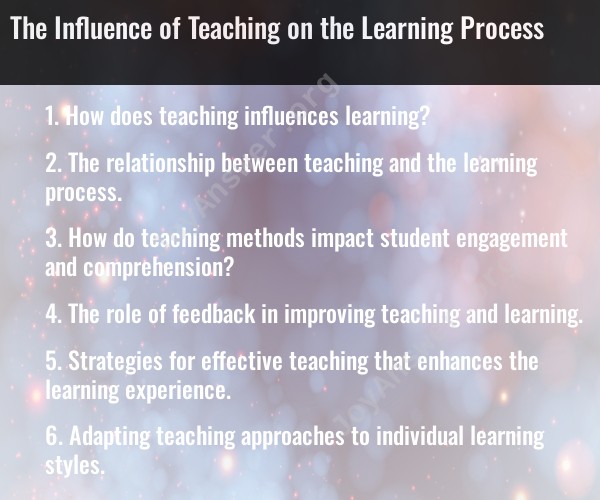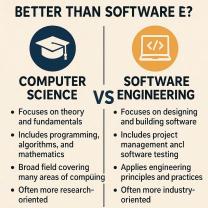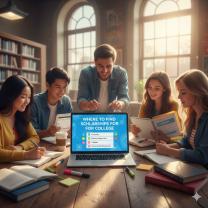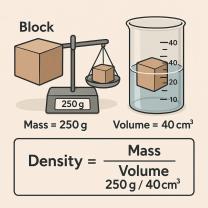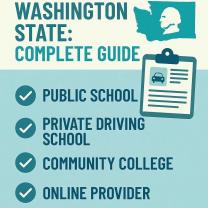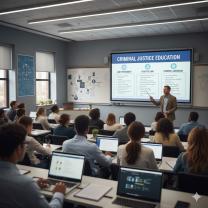How does teaching influences learning?
Teaching has a profound influence on the learning process, and the relationship between teaching and learning is intricate and reciprocal. Here are some of the key ways in which teaching influences learning:
Knowledge Transfer: Teaching is the process of transferring knowledge and information from the teacher to the learner. Through lectures, demonstrations, discussions, and other instructional methods, teachers convey essential content and concepts to students.
Guidance and Structure: Teachers provide structure and guidance for the learning process. They help students organize and understand complex information, breaking it down into manageable chunks, and providing a logical sequence of topics.
Motivation and Engagement: Effective teaching methods can inspire and motivate students. A passionate and skilled teacher can create enthusiasm for a subject, making students more engaged and eager to learn.
Clarification and Explanation: Teachers can clarify confusing or challenging concepts, answer questions, and provide explanations that help students comprehend difficult material. This clarification is essential for students to build a solid foundation of understanding.
Feedback and Assessment: Teachers provide feedback and assessment on students' work, helping them understand their strengths and areas for improvement. This feedback loop is crucial for the learning process as it informs students how to progress.
Facilitation of Critical Thinking: Teachers can encourage and model critical thinking and problem-solving skills. By presenting thought-provoking questions and promoting discussion, they guide students in developing their analytical and reasoning abilities.
Scaffolding: Teachers provide scaffolding, which means offering support and guidance at the appropriate level of challenge. This support can help students build their skills and knowledge gradually, leading to more complex and independent learning.
Personalization: Effective teachers take into account the individual needs, interests, and abilities of their students. They may tailor their teaching approaches to accommodate different learning styles and preferences.
Modeling Behavior: Teachers serve as role models for behavior and attitudes related to learning. Students often emulate their teachers' study habits, work ethics, and attitudes toward learning.
Cultivation of Metacognition: Teachers can help students become more aware of their own learning processes through metacognition. They encourage students to reflect on their learning strategies, set goals, and evaluate their progress.
Creating a Supportive Environment: A positive and supportive classroom environment, created by teachers, can foster a sense of safety and belonging, which is conducive to learning. When students feel comfortable, they are more likely to take risks and explore new ideas.
Active Learning: Teachers can use active learning strategies that engage students in problem-solving, discussions, and hands-on activities, which enhance the learning experience and make it more interactive and participatory.
Adaptation to Student Needs: Good teachers adapt their teaching methods to meet the diverse needs of their students. They differentiate instruction to accommodate various learning styles, abilities, and backgrounds.
Continuous Improvement: Teachers who continually seek professional development and self-improvement can enhance their teaching effectiveness over time, benefiting their students' learning experiences.
In summary, teaching is a dynamic process that directly shapes the learning experience of students. Effective teaching not only imparts knowledge but also fosters motivation, critical thinking, and a positive learning environment. The influence of teaching on learning is a critical factor in educational success, and the quality of teaching plays a significant role in how well students acquire and apply knowledge and skills.
- The relationship between teaching and the learning process.
Teaching and learning are two sides of the same coin. Teaching is the process of helping students learn, and learning is the process of acquiring knowledge and skills. The two processes are inextricably linked, and effective teaching leads to effective learning.
There are many different theories of teaching and learning, but most agree that the process is complex and multifaceted. It involves a number of factors, including the teacher, the student, the learning environment, and the curriculum.
Teachers play a vital role in the learning process. They are responsible for creating a positive and supportive learning environment, providing clear and concise instructions, and assessing student learning. Teachers also need to be able to adapt their teaching methods to the individual needs and learning styles of their students.
Students also play an active role in the learning process. They need to be motivated to learn, be able to focus and pay attention, and be able to process and understand new information. Students also need to be able to apply what they have learned to new situations.
The learning environment can also have a significant impact on student learning. A positive learning environment is one where students feel safe, respected, and supported. It is also a place where students have access to the resources they need to learn.
The curriculum also plays a role in the learning process. The curriculum should be challenging and engaging, and it should provide students with the knowledge and skills they need to succeed in school and in life.
How do teaching methods impact student engagement and comprehension?
Teaching methods can have a significant impact on student engagement and comprehension. Effective teaching methods are those that are engaging and relevant to students' interests. They should also be challenging and provide students with opportunities to learn at their own pace.
Some teaching methods that have been shown to be effective include:
- Inquiry-based learning: This type of learning involves students actively investigating and exploring topics.
- Problem-based learning: This type of learning involves students working together to solve problems.
- Cooperative learning: This type of learning involves students working together in small groups to complete tasks.
- Differentiated instruction: This type of instruction involves tailoring the learning experience to the individual needs of each student.
- The role of feedback in improving teaching and learning.
Feedback is an essential part of the teaching and learning process. Feedback provides students with information about their progress and helps them to identify areas where they need to improve. Feedback can also help teachers to improve their teaching methods.
Effective feedback is specific, timely, and constructive. It should focus on the student's work, not the student personally. Feedback should also be clear and concise, and it should be provided in a supportive and encouraging manner.
- Strategies for effective teaching that enhances the learning experience.
There are many strategies that teachers can use to enhance the learning experience for their students. Some of these strategies include:
- Creating a positive and supportive learning environment.
- Using a variety of teaching methods and activities.
- Providing students with opportunities to collaborate and work together.
- Giving students feedback on their progress.
- Encouraging students to be reflective learners.
- Adapting teaching approaches to individual learning styles.
All students learn in different ways. Some students learn best by listening, while others learn best by doing. Some students learn best by reading, while others learn best by watching.
Teachers can adapt their teaching approaches to individual learning styles by:
- Using a variety of teaching methods and activities.
- Providing students with multiple ways to demonstrate their learning.
- Giving students choices about how they learn.
- Creating a flexible learning environment.
By adapting their teaching approaches to individual learning styles, teachers can help all students succeed.
Here are some additional tips for effective teaching:
- Be prepared. This means knowing your subject matter inside and out, and having a clear plan for each lesson.
- Be organized. This means having your materials ready and prepared before class starts.
- Be enthusiastic. Your enthusiasm for the subject matter will be contagious and will help to motivate your students.
- Be flexible. Things don't always go according to plan, so be prepared to adapt your lesson as needed.
- Be patient. Learning takes time and effort, so be patient with your students and celebrate their successes along the way.
Teaching is a challenging but rewarding profession. By using effective teaching strategies and adapting your teaching approaches to individual learning styles, you can help all of your students succeed.
